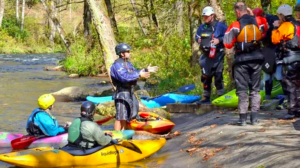
Surge in paddlesports accidents due to lack of safety training

Latest figures released in the USA point to a dangerous lack of training when it comes to paddlesports.
“We know from analysing US Coast Guard data that in 2020, nearly three-quarters (74.6 per cent) of people who died in paddling accidents had less than 100 hours experience in the activity,” says Water Sports Foundation (WSF) executive director Jim Emmons, “and over one-third (38.8 per cent) had less than 10 hours experience.”
According to the latest US data (2020 – from the Outdoor Foundation, USA) a record 37.9 million participants engaged in paddlesports like kayaking, canoeing and stand-up paddleboarding during the pandemic. This surge brought an estimated 2.5 million new paddlers to American waterways. However, it increased accidents to 331 and fatalities to a record high of 202 – accounting for more than 26% of all boating fatalities that same year.
Emmons believes boating in general is still one of the safest forms of recreation, but the data indicates most paddlesports deaths occurred due to lack of safety training and experience.
“People are drawn to paddlesports,” says Robin Pope, chairman of the board of directors of the American Canoe Association. “And why not? It’s fun, accessible and inexpensive. It’s easy to get your craft to the water, no license required, no marina fees, no fuel to buy and plenty of great exercise.”
While Pope supports greater participation, he’s also concerned that many newcomers to the sport simply don’t recognise the hazards.
“Data tells us most accidents happen in flatwater due to falling overboard or capsizing,” says Pope. “Untrained paddlers usually don’t know how to get back in once they’ve fallen out, aren’t wearing a life jacket and aren’t prepared for cold water exposure. It’s imperative that we help more paddlecraft purchasers take advantage of the many free and inexpensive safety education resources available to them.”
Emmons and Pope say sales associates rarely provide guidance or safety training, especially at stores selling entry-level paddle craft. And, in the US, most states do not require the purchaser to take a boating safety course, as some states do for motorised vessels.
Walt Taylor, the recreational boating specialist for the US Coast Guard’s First District, headquartered in Boston, believes a change in mindset would boost safety training while decreasing incidents and deaths.
“Many paddlers do not consider themselves ‘boaters’ and therefore don’t realise they are required by law to obey navigation rules and carry the required safety equipment for their size and type of vessel,” says Taylor. “By taking a recognised paddle safety course, paddlers will learn the basics about navigation rules, aids to navigation, risk management, and required and recommended safety gear.”
Additional data from the US Coast Guard shows 85 per cent of all paddlesports drowning victims were not wearing a life jacket and that alcohol has long been the leading known contributing factor in fatal boating accidents.
